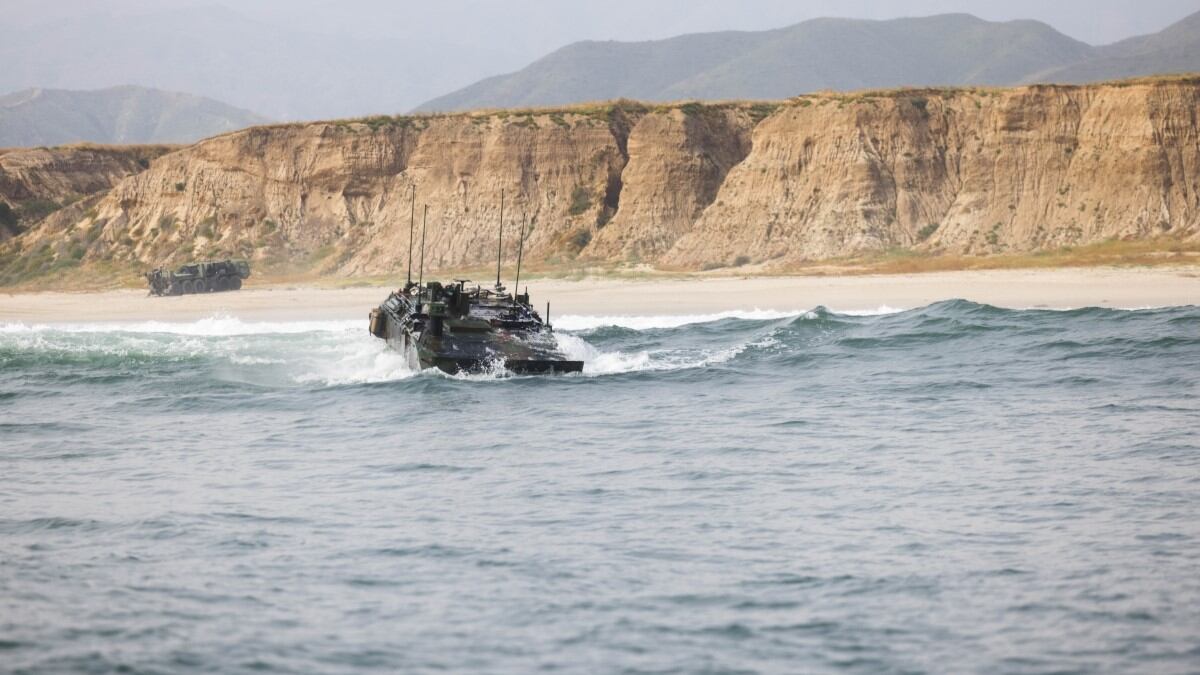The Marine Corps plans to wrap up the recertification of amphibious vehicle operators, in a process prompted by a series of mishaps, but the timeline for deploying the vehicle remains unclear.
The service remains on track to recertify all roughly 300 operators of the amphibious combat vehicle on how to operate it safely in water, according to Marine spokesman Capt. Ryan Bruce and previous statements by Marine leaders. The training focuses on differences between the new platform and its predecessor, the amphibious assault vehicle.
Like the amphibious assault vehicle, the amphibious combat vehicle can emerge from a ship’s well deck, traverse waters and roll ashore, making it an important platform for the military’s amphibious force.
But the bigger, wheeled amphibious combat vehicle has a V-shaped hull and internal systems that work differently from those in the tracked, flat-bottomed amphibious assault vehicle, Bruce told Marine Corps Times in April. As a result, the two vehicles behave differently in the surf zone, according to Bruce.
The Corps established a transition training unit in February after preliminary findings from investigations into three vehicle flips, in which no injuries were reported, recommended operators get better trained on differences between the new vehicle and its predecessor.
The unit recertified 59 operators and approximately 30 maintainers in June and July, Marine Corps Times previously reported. The remaining 240 operators to 250 operators and approximately 50 maintainers still needed to get recertified, Lt. Col. Frederick Monday, the officer in charge of the unit, said in July.
For now, the Marine Corps isn’t authorizing the vehicle to transit the surf zone with embarked troops or when the average height of the tallest waves are at 4 feet or higher, according to Bruce.
The service is working toward lifting that restriction, but “we are not going to speculate on the timeline for this action,” Bruce said via email Dec. 5.
In response to a Marine Corps Times question about when the amphibious combat vehicle could be deployed, Bruce said the Corps is taking “a deliberate approach” to fielding the platform.
“We’re being prudent about this,” he said. “Our Marines are training and experimenting with the platform as we speak, but the service is not going to rush into announcing capabilities on upcoming deployments until we are certain we have done our homework.”
The amphibious combat vehicle was involved in one recent mishap on land: a Dec. 12 rollover at Camp Pendleton, California, that killed Sgt. Matthew K. Bylski. The Marine Corps said it was investigating the accident.
The Corps in 2021 ceased deployments of the amphibious assault vehicle, the older platform, the year after a sinking that killed eight Marines and a Navy corpsman. But the East Coast’s 2nd Assault Amphibian Battalion retains the vehicle, according to Bruce.
The newer amphibious combat vehicle has experienced mechanical problems with its shock absorbers and central tire inflation system, then-Commandant Gen. David Berger first acknowledged to Congress in March.
BAE Systems convened a task force in early 2023 to “to design and implement requested changes as greater numbers of vehicles are fielded,” Garrett Lacaillade, the company’s vice president of amphibious programs, said Nov. 15 in response to a Marine Corps Times question about whether BAE Systems had resolved those mechanical issues.
“As a result, since late summer, we have provided and will continue to provide lifecycle support and focused upgrades to meet the Marine Corps’ operational needs,” Lacaillade said in a statement.
Irene Loewenson is a staff reporter for Marine Corps Times. She joined Military Times as an editorial fellow in August 2022. She is a graduate of Williams College, where she was the editor-in-chief of the student newspaper.




